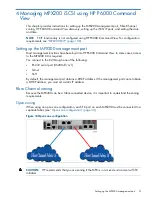
2 Planning the MPX200 installation
Prior to installation, it is important to define the requirements for server connectivity and MPX200
multifunction usage. You should consider present and future needs as they relate to MPX200
configuration attributes and installation recommendations.
Installation recommendations
Before installing the HP MPX200 Multifunction Router, HP recommends that you:
•
Develop an installation and configuration plan for your FC-SAN and Ethernet IP-SAN
environments.
•
Review all documentation.
•
Determine if the IP-SAN is lossy or lossless (Enhanced Ethernet) and if iSCSI or FCoE is
deployed.
The MPX200 supports the following functions: iSCSI-FCoE, FCIP, Data Migration. For simultaneous
operation, you can configure the MPX200 chassis with a single blade or dual blades to run up to
two functions per blade in the combinations shown in
Table 3 (page 20)
.
Table 3 MPX200 blade configurations
Dual-blade chassis (blade1/blade2)
Single blade chassis (blade1/empty)
iSCSI-FCoE/iSCSI-FCoE
iSCSI-FCoE/empty
iSCSI-FCoE-FCIP/iSCSI-FCoE-FCIP
iSCSI-FCoE-FCIP/empty
iSCSI-FCoE-DMS/iSCSI-FCoE-DMS
iSCSI-FCoE-DMS/empty
FCIP/FCIP
FCIP/empty
DMS/DMS
DMS/empty
iSCSI-FCoE-DMS/iSCSI-FCoE-FCIP
iSCSI-FCoE-FCIP/iSCSI-FCoE-DMS
•
Simultaneous iSCSI and FCoE are considered one function. FCoE is only supported with
10-GbE models.
•
When configuring for blade redundancy, you must configure both blades. To add a redundant
blade, you must un-present/re-present existing LUN presentations to gain access through the
second blade.
NOTE:
When configured for iSCSI bridging, HP recommends use of the same blade option
type (1 GbE or 10GbE-1GbE) in a common chassis to ensure balanced performance in a
redundant configuration.
•
Dual-blade iSCSI-FCoE configurations are always configured for high availability.
•
Dual-blade FCIP configurations can be configured for separate operation or high availability.
•
A license is required for FCIP, half-chassis or full chassis.
•
A license is required for data migration, 1TB, 5TB, or 1 Array. FCIP is not required for remote
data migration.
NOTE:
For more information on data migration, see the Data Migration Services User's Guide.
Table 4 (page 21)
describes the MPX200 supported configuration maximums for ports, blades,
and chassis.
20
Planning the MPX200 installation
















































